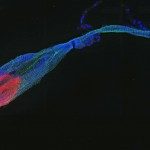Lien vers Pubmed [PMID] – 27456078
Malar. J. 2016 07;15(1):387
BACKGROUND: In many African countries malaria has declined sharply due to a synergy of actions marked by the introduction of vector control strategies, but the disease remains a leading cause of morbidity and mortality in Central African Republic (CAR). An entomological study was initiated with the aim to characterize the malaria vectors in Bangui, the capital of CAR, and determine their vector competence.
METHODS: A cross-sectional entomological study was conducted in 15 sites of the district of Bangui, the capital of CAR, in September-October 2013 and a second collection was done in four of those sites between November and December 2013. Mosquitoes were collected by human landing catch (HLC) indoors and outdoors and by pyrethrum spray catch of indoor-resting mosquitoes. Mosquitoes were analysed for species and multiple other attributes, including the presence of Plasmodium falciparum circumsporozoite protein or DNA, blood meal source, 2La inversion karyotype, and the L1014F kdr insecticide resistance mutation.
RESULTS: Overall, 1292 anophelines were analysed, revealing a predominance of Anopheles gambiae and Anopheles funestus, with a small fraction of Anopheles coluzzii. Molecular typing of the An. gambiae complex species showed that An. gambiae was predominant (95.7 %) as compared to An. coluzzii (2.1 %), and Anopheles arabiensis was not present. In some areas the involvement of secondary vectors, such as Anopheles coustani, expands the risk of infection. By HLC sampling, An. funestus displayed a stronger endophilic preference than mosquitoes from the An. gambiae sister taxa, with a mean indoor-capture rate of 54.3 % and 67.58 % for An. gambiae sister taxa and An. funestus, respectively. Human biting rates were measured overall for each of the species with 28 or 29 bites/person/night, respectively. Both vectors displayed a strong human feeding preference as determined by blood meal source, which was not different between the different sampling sites. An. coustani appears to be highly exophilic, with 92 % of HLC samples captured outdoors. The mean CSP rate in head-thorax sections of all Anopheles was 5.09 %, and was higher in An. gambiae s.l. (7.4 %) than in An. funestus (3.3 %). CSP-positive An. coustani were also detected in outdoor HLC samples. In the mosquitoes of the An. gambiae sister taxa the kdr-w mutant allele was nearly fixed, with 92.3 % resistant homozygotes, and no susceptible homozygotes detected.
CONCLUSIONS: This study collected data on anopheline populations in CAR, behaviour of vectors and transmission levels. Further studies should investigate the biting behaviour and susceptibility status of the anophelines to different insecticides to allow the establishment of appropriate vector control based on practical entomological knowledge.

